Optimizing Ridge–Furrow Rainwater-Harvesting Strategies for Potato Cultivation in the Drylands of Northwestern China: A Regional Approach
Abstract
1. Introduction
2. Materials and Methods
2.1. Study Area
2.2. Data Collection
2.3. Research Methods
2.3.1. Ecological Water Requirement (ETm)
2.3.2. Runoff Depth (Q)
2.3.3. Ridge–Furrow Ratio
2.3.4. Hydrological Year and Crop Water Surplus–Deficit
3. Results
3.1. Precipitation, Evapotranspiration, and Surplus–Deficit during Potato Growth Periods
3.2. Relationship between Rainfall and Rainwater Harvesting
3.3. The Appropriate Rainwater-Harvesting Technology for Different Regions in Northwest China
4. Discussion
4.1. Cultivation Pattern
4.2. Climate and Climate Change
5. Conclusions
Author Contributions
Funding
Data Availability Statement
Acknowledgments
Conflicts of Interest
References
- Chen, Y.; Chai, S.; Tian, H.; Chai, Y.; Li, Y.; Chang, L.; Cheng, H. Straw strips mulch on furrows improves water use efficiency and yield of potato in a rainfed semiarid area. Agric. Water Manag. 2018, 211, 142–151. [Google Scholar] [CrossRef]
- Chen, H.; Lai, Y.; Hong, L.; Mei, C.; Gao, X.F. A review of research furrow and ridge rainwater harvesting System in dry areas. Water Sav. Irrig. 2015, 7, 81–85. (In Chinese) [Google Scholar] [CrossRef]
- Deng, X.P.; Shan, L.; Zhang, H.; Turner, N.C. Improving agricultural water use efficiency in arid and semiarid areas of China. Agric. Water Manag. 2006, 80, 23–40. [Google Scholar] [CrossRef]
- Wang, J.-B.; Xie, J.-H.; Li, L.-L.; Adingo, S. Review on the fully mulched ridge–furrow system for sustainable maize production on the semi-arid Loess Plateau. J. Integr. Agric. 2023, 22, 1277–1290. [Google Scholar] [CrossRef]
- Feng, R.L.; Song, L.Z.; Geballe, G.T. Water use patterns and agronomic performance for some cropping systems with and without fallow crops in a semi-arid environment of northwest China. Agric. Ecosyst. Environ. 2000, 79, 129–142. [Google Scholar]
- Lester, B.; Brian, H.; Yang, F. China’s water shortage will affect world food security. China Rural. Econ. 1998, 7, 22–29. (In Chinese) [Google Scholar]
- Sun, M.Y.; Chen, W.; Lapen, D.R.; Ma, B.; Lu, P.; Liu, J.H. Effects of ridge-furrow with plastic film mulching combining with various urea types on water productivity and yield of potato in a dryland farming system. Agric. Water Manag. 2023, 283, 108318. [Google Scholar] [CrossRef]
- Zhou, L.M.; Jin, S.L.; Liu, C.A.; Xiong, Y.C.; Si, J.T.; Li, X.G.; Gan, Y.T.; Li, F.M. Ridge–furrow and plastic-mulching tillage enhances maize-soil interactions: Opportunities and challenges in a semiarid agroecosystem. Field Crops Res. 2012, 126, 181–188. [Google Scholar] [CrossRef]
- Yang, F.K. Study on Micro-rainwater planting Technique of Ridge Film Mulching ang Furrow Seeding of Spring Wheat in Dayland. J. Irrig. Drain. 2004, 4, 47–49. (In Chinese) [Google Scholar] [CrossRef]
- Wu, W.; Liao, Y.C. The Research Progress and Prospects of Ridge and Furrow Rainwater Harvesting System in arid Arid Regions of China. Northwest J. Agric. 2014, 23, 1–9. (In Chinese) [Google Scholar] [CrossRef]
- Deng, H.L.; Zhang, H.J.; Xiao, R.; Zhang, Y.L.; Tian, J.L.; Li, F.Q.; Wang, Y.C.; Zhou, H.; Li, X. Effects of different cover cropping methods on soil hydrothermal effect and corn yield in Longzhong semi-arid zone. Chin. Agric. Sci. 2020, 53, 273–287. (In Chinese) [Google Scholar] [CrossRef]
- Liu, P.; Liu, X.L.; Wang, J.J.; Cai, T.; Zhang, P.; Ren, X.L.; Jia, Z.K.; Chen, X.L. Effects of rainfed cropping pattern on soil moisture and crop yield in wheat-corn annual farmland. J. Irrig. Drain. 2019, 38, 37–43. (In Chinese) [Google Scholar] [CrossRef]
- Qiang, S.C.; Zhang, H.J.; Mo, F.; Zhao, H.; Xiong, Y.C. The Effects of micro-rainwater harvesting patterns and rainfall variability on water ecological stoichiometry in oa (Avena sativa L.). Field. J. Ecol. 2011, 31, 2365–2373. (In Chinese) [Google Scholar]
- Zhou, Y.J.; Pu, X.K.; Wu, C.H.; Miao, F.F.; Li, R. Effects of different Degradation Plastic Film with Furrow Mulch under Ridge-Furrow Planting on Farmland Potato Yield and Soil Water and Heat. J. Nucl. Agric. 2021, 35, 2664–2673. (In Chinese) [Google Scholar] [CrossRef]
- Chen, X.J.; Zhang, X.D.; Han, Z.Z.; Zhang, P.; Jia, Z.K.; Lian, Y.H.; Han, Q.F. Fertilizer effect and its contribution to yield increase of cereals grown in furrow and ridge rainfed cultivation in semi-arid areas. J. Crops 2018, 44, 1055–1066. [Google Scholar] [CrossRef]
- Kou, J.T.; Shi, S.L.; Cai, Z.S. Effects of Ridge and Furrow Rainfall Harvesting on Growth Characteristics and Quality of Medicago in Dryland. Chin. Agric. Sci. 2010, 43, 5028–5036. (In Chinese) [Google Scholar] [CrossRef]
- Zhong, Z. Soil Water Dynamics and Water Use Efficiency under Double Ridge and Geotextile Mulching Conditions in Dryland; Chang’an University: Xi’an, China, 2021; (In Chinese). [Google Scholar] [CrossRef]
- Liu, X.; He, P.; Jin, J.; Zhou, W.; Sulewski, G.; Phillips, S. Yield Gaps, Indigenous Nutrient Supply, and Nutrient Use Efficiency of Wheat in China. Agron. J. 2011, 103, 1452–1463. [Google Scholar] [CrossRef]
- Dai, H.F.; Zhang, Z.F. Study on the cultivation model of improving quality and efficiency of potatoes in Hexi Irrigation Area. Agric. Sci. Technol. Inf. 2019, 24, 13–15. (In Chinese) [Google Scholar] [CrossRef]
- Wang, H.L.; Zhang, X.C.; Yu, X.F.; Ma, Y.F.; Hou, H.Z. Soil Hydrothermal Effect of Black Film Cover and Its Effect on Potato Yield; Crop Science; Crop Science Society of China (CSC): Beijing, China, 2015. [Google Scholar]
- Zhao, H.; Xiong, Y.C.; Li, F.M.; Wang, R.Y.; Qiang, S.C.; Yao, T.F.; Mo, F. Plastic film mulch for half growing-season maximized WUE and yield of potato via moisture-temperature improvement in a semi-arid agroecosystem. Agric. Water Manag. 2012, 104, 68–78. [Google Scholar] [CrossRef]
- Zhang, L.H.; Kang, L. Big ridge mechanization planting technology for potato in Hailar area of Hulunbuir City. Jiangsu Agric. Sci. 2018, 46, 67–71. (In Chinese) [Google Scholar] [CrossRef]
- Xu, X.; He, P.; Zhao, S.; Qiu, S.; Johnston, A.M.; Zhou, W. Quantification of yield gap and nutrient use efficiency of irrigated rice in China. Field Crops Res. 2016, 186, 58–65. [Google Scholar] [CrossRef]
- Penman, H.L. Natural evaporation from open water, bare soil and grass. Proc. R. Soc. Lond. Ser. A Math. Phys. Sci. 1948, 193, 120–145. [Google Scholar]
- Allen, R.G.; Pereira, L.S.; Raes, D.; Smith, M. Crop evapotranspiration-Guidelines for computing crop water requirements-FAO Irrigation and drainage paper 56. FAO Rome 1998, 300, 56. [Google Scholar]
- Allen, R.G.; Pereira, L.S.; Howell, T.A.; Jensen, M.E. Evapotranspiration information reporting: I. Factors governing measurement accuracy. Agric. Water Manag. 2011, 98, 899–920. [Google Scholar] [CrossRef]
- Pereira, L.; Paredes, P.; Jovanovic, N. Soil water balance models for determining crop water and irrigation requirements and irrigation scheduling focusing on the FAO56 method and the dual Kc approach. Agric. Water Manag. 2020, 241, 106357. [Google Scholar] [CrossRef]
- Wang, H.L.; Wang, R.Y.; Zhang, Q.; Niu, J.Y.; Lu, X.D. Impact of warming climate on crop water requirement in Gansu Province. Chin. J. Eco-Agric. 2011, 19, 866–871. (In Chinese) [Google Scholar] [CrossRef]
- Valiantzas, J.D.; Hydrol, J. Simplified versions for the Penman evaporation equation using routine weather data. J. Hydrol. 2006, 331, 690–702. [Google Scholar] [CrossRef]
- Li, C.Q.; Li, B.G.; Hong, K.Q. Trend of crop water requirement in recent 35 years in Hebei Province. Chin. J. Eco-Agric. 2009, 17, 359–363. (In Chinese) [Google Scholar] [CrossRef]
- Tang, J.; Wang, J.; He, D.; Huang, M.; Pan, Z.; Pan, X. Comparison of the impacts of climate change on potential productivity of different staple crops in the agro-pastoral ecotone of North China. J. Meteorol. Res. 2016, 30, 983–997. [Google Scholar] [CrossRef]
- Sokolov, A.A.; Chapman, T.G. Methods for Water Balance Computations: An International Guide for Research and Practice; UNESCO: Paris, France, 1974. [Google Scholar]
- Mishra, S.K.; Pandey, A.; Singh, V.P. Special Issue on Soil Conservation Service Curve Number (SCS-CN) Methodology. J. Hydrol. Eng. 2012, 17, 1157. [Google Scholar] [CrossRef]
- Wei, W.Q.; Xie, S.Q. The Applica of Remote Sensing in Runoff Formation in SCS Model. Environ. Remote Sens. 1992, 4, 243–250. (In Chinese) [Google Scholar]
- Wang, Y. Optimizing and Improving SCS-CN Method in Loess Plateau; Graduate School of Chinese Academy of Sciences (Research Center for Soil and Water Conservation and Ecological Environment, Ministry of Education): Beijing, China, 2008. [Google Scholar]
- Liu, X.Z.; Kang, S.Z.; Liu, D.L.; Zhang, X.P. SCS model based on geographic information and its application to simulate rainfall-runoff relationship at typical small watershed level in Loess Plateau. Trans. Chin. Soc. Agric. Eng. 2005, 5, 93–97. [Google Scholar] [CrossRef]
- Hu, Q.; Pan, X.B.; Yang, N. Suitability of rainwater harvesting technology for potato farmland ridge and furrow in Northern Agro-pastoral Zone of China. Arid. Land. Geogr. 2015, 38, 585–591. (In Chinese) [Google Scholar] [CrossRef]
- Wang, Y.C. Rainwater Planting Increases Ridge-Furrow Ratio and Density and Its Regulatory Effects on Spring Maize Dry Matter and Nitrogen Accumulation. Master’s Thesis, Northwest A&F University, Xianyang, China, 2023. (In Chinese). [Google Scholar] [CrossRef]
- Zhao, H.; Wang, R.Y.; Ma, B.L.; Xiong, Y.C.; Qiang, S.C.; Wang, C.L.; Liu, C.A.; Li, F.M. Ridge-furrow with full plastic film mulching improves water use efficiency and tuber yields of potato in a semiarid rainfed ecosystem. Field Crops Res. 2014, 161, 137–148. [Google Scholar] [CrossRef]
- Wang, L.F.; Shangguan, Z.P. Water–use efficiency of dryland wheat in response to mulching and tillage practices on the Loess Plateau. Sci. Rep. 2015, 5, 12225. [Google Scholar] [CrossRef] [PubMed]
- Liu, C.D. Dryland double ridge full film covering rainwater potato cultivation technology—A case study of Tongren area in Qinghai. Chin. Hortic. Dig. 2011, 27, 137–138. (In Chinese) [Google Scholar] [CrossRef]
- Cai, K.T.; Shen, Q.W.; Tu, X.L.; Wang, H.W. Effects of Different Cultivation Methods on the Growth and Yield of the Winter Eshu No.4; Hubei Agricultural Science: Wuhan, China, 2014; Volume 53, pp. 4812–4813+4816, (In Chinese). [Google Scholar] [CrossRef]
- Chen, Y.; Zhang, Z.; Ma, Z.; Jia, L.; Qin, Y.; Fan, M. Mini-Ridge with Covering and Side Planting Method Enhances Rainwater Collection and the Yield of Rain-fed Potato. Am. J. Potato Res. 2017, 94, 599–605. [Google Scholar] [CrossRef]
- Chen, M. Experimental study on different film and mulching methods for potato. Seed Sci. Technol. 2022, 40, 13–15. (In Chinese) [Google Scholar] [CrossRef]
- Chen, J.; He, J.H.; Liu, J.L.; Tang, J.H.; Wu, N. Effects of Different Planting patterns on Starch Formation and Yield in Semi-Arid Areas. J. Crops 2020, 3, 169–176. (In Chinese) [Google Scholar] [CrossRef]
- Cheng, D.J.; Guo, F.T.; Liu, S.Q.; Wang, D.W.; Gao, R. A Study on the dynamic changes of soil nutrients and soil enzyme activities of potato field affected by plastic film covering and fertilizer in the cold and semi-arid areas of high plateau. J. Hebei Agric. Univ. 2004, 6, 16–21. (In Chinese) [Google Scholar] [CrossRef]
- Dai, H.L.; Qin, S.H.; Zhang, J.L.; Wang, D.; Wang, C.L.; Chen, L. Effects of plastic film and ridge-furrow cropping patterns on growth ang yield of potato in semiarid areas. Arid Zone Agric. Res. 2012, 30, 56–60. (In Chinese) [Google Scholar] [CrossRef]
- Dong, Z.S.; Han, Y.G. Comparative study on different cultivation modes of spring sown potato. Agric. Sci. Technol. Newsl. 2021, 9, 134–136. (In Chinese) [Google Scholar] [CrossRef]
- Duan, Y.; Tuo, D.B.; Zhao, P.Y.; Li, H.C. Study on the Technic of Covering Ridge then Planting in Furrow and Collecting Rain-water in Field in North of the Loess Altiplano. J. North China Agric. Univ. 2006, S3, 44–47. (In Chinese) [Google Scholar] [CrossRef]
- Fan, S.J.; Wang, T.; Zhang, J.L.; Bai, J.P.; Song, J.Z.; Ma, Z.J. Effects of tillage strategies on the topsoil content and the yield of potato. J. Grass Ind. 2012, 21, 271–279. (In Chinese) [Google Scholar]
- Guo, J.S.; Li, W.G.; Cao, C.M.; Zhang, J.P.; Zhang, Q.P.; Zhang, Y.F. Experiment on High-Yield Cultivation Technology of Potato Film Mulching in Dry Land of Central and Western Inner Mongolia. Potato Ind. Food Secur. 2009, 4. (In Chinese) [Google Scholar]
- He, Y.; Li, M.H.; Feng, X.B.; Zhuo, G. Effects of ground film and open field cultivation on the traits of yellow and purple potatoes. Anhui Agric. Bull. 2017, 23, 44–45. (In Chinese) [Google Scholar] [CrossRef]
- Hou, H.-Z.; Wang, J.; Zhang, X.-C.; Fang, Y.-J.; Yu, X.-F.; Wang, H.-L.; Ma, Y.-F. Effects of Mini-ditch Planting with Plastic Mulching in Ridges on Soil Water Content, Temperature and Potato Yield in Rain-fed Semiarid Region. Acta Agron. Sin. 2015, 41, 1582–1590. [Google Scholar] [CrossRef]
- Hu, Q.; Pan, F.; Pan, X.; Zhang, D.; Yang, N.; Pan, Z.; Zhao, P.; Tuo, D. Effects of a ridge-furrow micro-field rainwater- harvesting system on potato yield in a semi-arid region. Field Crops Res. 2014, 166, 92–101. [Google Scholar] [CrossRef]
- Hu, Q.; Tan, Y.; Yang, P.Y. Effects of different ridge and furrow widths for rainwater harvesting on the potato at ecotone region in the north foot of Yinshan Mountain. J. Arid Land Resour. Environ. 2017, 31, 116–121. (In Chinese) [Google Scholar] [CrossRef]
- Huang, C.L.; Xiao, J.W.; Sun, G.Q.; Li, J.S. Test and demonstration of high yield potatoes planting in autumn and win-terand the introduction of cultivation technology. Guangxi J. Agron. 2018, 33, 16–19. (In Chinese) [Google Scholar] [CrossRef]
- Jiang, C.X.; Zhang, W.; He, T.F.; Zhang, H.H.; Zhao, Z.X.; Liu, E.K.; Kang, R.K. Effects of Ridging Planting on Soil Moisture and Temperature, the Yield of Dryland Potato. Anhui Agric. 2018, 184, 24–36. (In Chinese) [Google Scholar] [CrossRef]
- Jie, W.Q.; Li, Y.S.; Wang, P.; Guo, T.S.; Li, F.D.; He, E.L.; Li, T. Effects of Various Cultivation Mode on Growth and Yield of Potato ‘Tianshu No.11’ in Mountain Dry Land. J. Northwest Agric. Sci. 2014, 23, 80–86. (In Chinese) [Google Scholar] [CrossRef]
- Kong, W.C. The Effects of Different Film Mulching and Soil Wetted Percentages on Soil Moisture and Heat Distribution and Potato Growth. Master’s Thesis, Yangzhou University, Yangzhou, China, 2021. (In Chinese). [Google Scholar] [CrossRef]
- Kuang, W.S.; Zhang, X.; Liu, Y.P.; Wang, Y.; Liang, H. Effects of different cultivation methods on yield and quality of winter-planting potato. Guangxi Agric. Sci. 2008, 1, 30–32. (In Chinese) [Google Scholar] [CrossRef]
- Li, J. Study on water-saving and yield-increasing of potato under double mulching with grass and film ang ridge culture drip irrigation under film. J. Liaoning Norm. Coll. (Nat. Sci. Ed.) 2021, 23, 102–104+108. (In Chinese) [Google Scholar] [CrossRef]
- Li, R.; Wang, Y.L.; Wu, P.N. Furrow and ridge mulching improved soil water and heat status to improve potato yield in southern Ningxia Arid region. Trans. Chin. Soc. Agric. Eng. 2017, 33, 168–175. (In Chinese) [Google Scholar] [CrossRef]
- Li, X.W. Experiments on different cultivation patterns of potato. Agric. Sci. Inf. 2018, 4, 5+12. (In Chinese) [Google Scholar] [CrossRef]
- Li, F.; Hou, X.Q.; Li, R. Effects of Dual-mulching of Ridge-and-Furrow on Water Consumption Characteristics, Yield and Water Use Efficiency of Potato in Dryland Farming. J. Nucl. Agric. 2019, 33, 2472–2481. (In Chinese) [Google Scholar] [CrossRef]
- Liang, J.X.; Guo, X.N.; Zhang, G.H.; Wang, X.N.; Zhou, T. Effect of Ridge with Plastic Cover and Furrow Sowing on Soil Water Content and Potato Yield in Dryland of Southern Ningxia. J. Irrig. Drain. 2015, 34, 67–72. (In Chinese) [Google Scholar] [CrossRef]
- Liu, S.X.; Ren, L.; Li, C.H. Impacts of ridge-mulching method on potato in semi-arid areas. Gansu Agric. Sci. Technol. 2014, 9, 36–38. (In Chinese) [Google Scholar] [CrossRef]
- Liu, W.X.; Dong, B.; Zhang, L.G.; Su, Z.T. Effects of Plastic Film Mulching Modes on Soil Moisture, Temperature and Yield of Potato in Semi-Arid Areas. China Potato 2018, 32, 13–18. (In Chinese) [Google Scholar]
- Liu, Z.Y.; Si, N.; Zeng, Y.T.; Xu, J.N.; Tan, S.Q.; Wei, H.; Li, S.P.; Ci, R.Z.G. Effects of different heights of ridging on potato yield. Mod. Agric. Sci. Technol. 2015, 8, 88–89. (In Chinese) [Google Scholar] [CrossRef]
- Luo, G.L.; Wang, H.X.; Nuerbiyan, B.; Duolaitijinag, M. Comparative experiment on different cultivation modes of potato. Chang. Veg. 2008, 8, 25–26. (In Chinese) [Google Scholar] [CrossRef]
- Mao, X.H.; Bai, X.D.; Qi, H.Y.; Fan, X.B.; Du, P.B.; Wang, X.T. Effects of different types of mulching and ridging on potato yield and quality. Agric. Dev. Equip. 2016, 11, 106+93. (In Chinese) [Google Scholar] [CrossRef]
- Niu, X.N.; Chai, Z.L. Selection Test on High Yield Cultivation Technology of Potato. Qinghai Agric. For. Sci. Technol. 2015, 4, 63–65. (In Chinese) [Google Scholar] [CrossRef]
- Qin, S.; Zhang, J.; Dai, H.; Wang, D.; Li, D. Effect of ridge–furrow and plastic-mulching planting patterns on yield formation and water movement of potato in a semi-arid area. Agric. Water Manag. 2014, 131, 87–94. [Google Scholar] [CrossRef]
- Ren, Y.F.; Lu, Z.Y.; Zhao, P.Y.; Gao, Y.; Liu, G.H.; Su, Y.F. Effects of Different Planting Methods on Water Utilization and Yield of Potato in Dryland. J. Crops 2019, 5, 120–124. (In Chinese) [Google Scholar] [CrossRef]
- Sima, L.L.; Xu, J. Research on efficient potato cultivation technology in southern mountainous area of Ningxia. Inn. Mong. Agric. Sci. Technol. 2007, 1, 42–43. (In Chinese) [Google Scholar] [CrossRef]
- Song, X.Y.; Wang, Q.; Hu, G.R.; Li, F.C.; Wang, H.L. Effects of ridge-furrow rainwater harvesting on soil moisture and alfalfa growth characteristics. Grassl. Turf 2017, 37, 60–67. (In Chinese) [Google Scholar] [CrossRef]
- Su, J.G.; Wang, C.Y.; Han, X.B.; Wang, X.; Ma, R.B.; Du, H. Study on the effects of different mulching methods on soil moisture and yield in dryland potato. Ningxia Agric. For. Sci. Technol. 2011, 52, 19–20+83. (In Chinese) [Google Scholar] [CrossRef]
- Sun, M.Y.; Liu, J.H.; Zhao, B.P.; Yang, Y.M.; Ma, B. Effects of whole plastic film mulching ridging cropping patterns on soil ther-mal-moisture status, soil enzyme activity and yield of rain fed potato. Arid Area Resour. Environ. 2018, 32, 133–139. (In Chinese) [Google Scholar] [CrossRef]
- Tan, W.J.; Wang, J.; Yang, R.Z.; Zhang, J.N.; He, W.C. Effects of different production modes on potato yield and water utilization efficiency. China Agric. Abstr.-Agric. Eng. 2021, 33, 50–54. (In Chinese) [Google Scholar] [CrossRef]
- Tian, Y.; Su, D.; Li, F.; Li, X. Effect of rainwater harvesting with ridge and furrow on yield of potato in semiarid areas. Field Crops Res. 2003, 84, 385–391. [Google Scholar] [CrossRef]
- Wang, J.L. Preliminary report on the comparative experiment of different cultivation modes of potato in southern mountainous area of Ningxia. Agric. Sci. Technol. Commun. 2016, 11, 104–106+110. (In Chinese) [Google Scholar] [CrossRef]
- Wang, K.B.; Chen, Y.P.; Zheng, T.B.; Wei, R.; Sun, Q.; Li, Y.; Shangguan, Z.P.; Zhang, Y.W. Effects of fertilization, ridging and variety on absorption and allocation of-nitrogen, phosphorus, and potassium in newly cultivated potato on the Loess Plateau. Agric. Res. Arid Areas 2022, 40, 144–152. (In Chinese) [Google Scholar] [CrossRef]
- Wang, K.B.; Zhang, Y.W.; Zheng, T.B.; Li, Y.; Sun, Q.; Wei, R.; Chen, Y.P. Preliminary Study on Potential for Potato Planting in New Cultivated Land in Yan’an. Shaanxi Agric. Sci. 2019, 66, 3–8. [Google Scholar] [CrossRef]
- Wang, Q.; Zhang, E.; Li, F.M.; Wang, X.L. Optimum ratio ridge to furrow for planting potato in semiarid areas. J. Agric. Eng. 2005, 2, 38–41. [Google Scholar] [CrossRef]
- Wang, X.L. Research on winter sowing cultivation technology of potato. Agric. Technol. Serv. 2011, 28, 1556+1561. (In Chinese) [Google Scholar] [CrossRef]
- Wang, X.L.; Chen, M.C.; Li, F.M.; Li, Y.J. Effects of additional water and increased soil temperature potato yields in Plas-tic-covered Ridge Rainwater-harvesting system. Agric. Res. Arid Areas 2007, 3, 11–16. (In Chinese) [Google Scholar] [CrossRef]
- Wang, X.L.; Dong, P.H.; Li, F.M.; Li, S.Q. Effects of Plastic-covered Ridge Rainwater Harvesting System on Potato Yield and Water and Nitrogen Use Efficiency. Henan Agric. Sci. 2007, 10, 84–87. (In Chinese) [Google Scholar] [CrossRef]
- Wang, Y.; Sun, X.J. Effects of Fertilization on Tuber Yield, Water and Fertilizer Use Efficiency under Different Rainfall Harvesting Planting Modes of Potato. Northwest J. Agric. 2018, 27, 203–212. (In Chinese) [Google Scholar] [CrossRef]
- Wang, Y.H.; Meng, M.L.; Chen, Y.J.; Zhang, J.; Wang, Z.H.; Cui, C.L. Effects of Different Film-covering Method on Yield and Soil Moisture of Dry Land Tillage Potato. China Agron. Bull. 2013, 29, 147–152. (In Chinese) [Google Scholar] [CrossRef]
- Wang, Y.Y.; Li, S.L.; Zhang, R. Effects of different cropping patterns on potato yield and fertilizer use efficiency. Zhejiang J. Agric. 2015, 27, 1802–1806. (In Chinese) [Google Scholar] [CrossRef]
- Wang, Z.D.; Liu, J.L.; He, J.H.; Cai, M.; Yang, Y.Y.; Man, B.J.; Yang, X.; Yan, C.H.; Wu, N. Effects of Planting Pattern on Agronomic Characters, Yield and Soil Hydrothermal Status of Potato in Mountainous Areas of Southern Ningxia. J. Jiangxi Agric. Sci. 2019, 33, 1–8. (In Chinese) [Google Scholar] [CrossRef]
- Wang, R.Q. Effects of Different Mulching Methods on Quality and Yield of Potato Dry Farming. Master’s Thesis, Northwest Agriculture and Forestry University, Xianyang, China, 2020. (In Chinese). [Google Scholar]
- Xiao, Y.D. Experimental study on different mulching methods of potato to collect rainwater, conserve moisture and increase yield. Gansu Agric. 2012, 8, 49–50. (In Chinese) [Google Scholar] [CrossRef]
- Xu, Y.J.; Sun, N.X.; Cen, J. Effect of Ehich Cultivated by Ridging and Covering Film on the Growth and Yield of Potato for Vegetables. North. Hortic. 2013, 14, 36–37. (In Chinese) [Google Scholar]
- Yang, F.; Shan, H.B.; Chen, B.Y. A Study of Benefits of Double Ridge Whole-mulching Rainwater Harvesting Furrow Sowing Technology for Dry-land Potato. Ningxia Agric. For. Sci. Technol. 2013, 54, 45–48+53. (In Chinese) [Google Scholar] [CrossRef]
- Yang, F.K.; He, B.L.; Dong, B.; Wang, L.M. Effects of Black Film Mulched Ridge-Furrow Tillage on Soil Water-Fertilizer Environment and potato yield and Benefit Under Different Rainfall Year in Semiarid Region. Chin. Agric. Sci. 2021, 54, 4312–4325. (In Chinese) [Google Scholar] [CrossRef]
- Yang, Q.Y.; Zang, Y. Comparative experiment on different cultivation modes of green potato No.9 in high altitude area. Qinghai Agric. Technol. Ext. 2015, 1, 38–39. [Google Scholar] [CrossRef]
- Yang, X.Q. Effects of different monopoly cropping patterns on potato growth. Spec. Econ. Plants Anim. 2022, 25, 6–7. (In Chinese) [Google Scholar] [CrossRef]
- Zeng, Y.T. Cultivation test and demonstration effect of potato high ridge double row with seed potato treatment and formula fertilization. Mod. Agric. Sci. Technol. 2016, 18, 60+64. (In Chinese) [Google Scholar] [CrossRef]
- Zhang, J.J. Ridging and Laminating Effects on Potato Yield and Quality. Master’s Thesis, Agricultural University of Hebei, Baoding, China, 2015. (In Chinese). [Google Scholar]
- Zhang, R.J.; Ma, H.; Nian, L.J.; Feng, Y.; Zhang, Y.H.; Tian, G.L. Experimental research on disaster reduction technology of potato dry-crop mulching film to preserve moisture and increase fertilizer with agro-mechanical and agronomic integra-tion. Mod. Rural Sci. Technol. 2015, 16, 62. (In Chinese) [Google Scholar] [CrossRef]
- Zhang, W.G. Effects of Film Mulching of Different Types on Potato Yield and Quality. J. Crops 2013, 1, 87–90. (In Chinese) [Google Scholar]
- Zhao, P.Y.; Jia, Y.Y.; Tuo, D.B.; Ren, Y.F.; Lu, Z.Y.; Li, H.C.; Duan, Y.; Gong, Q. Study on the Mechanism of Yield Increasing of Furrow Planting on Rain-fed Field in North Foot of Yinshan Mountain. Chin. Agric. Sci. Bull. 2014, 30, 165–170. (In Chinese) [Google Scholar] [CrossRef]
- Zhe, J.L.; Yang, Q.; Jing, Z.Z.; Chang, L.; Yang, H.Y. Comparison of Potato Yields by Different Cultivation Modes in Ningnan Mountain Areas. Ningxia Agric. For. Sci. Technol. 2013, 54, 49–50. (In Chinese) [Google Scholar] [CrossRef]
- Zheng, Y.H.; Wang, S.; He, K.X.; Mao, S.H. Research on the effect of different cultivation methods on potato yield. Tillage Cultiv. 2008, 3, 12–13+41. (In Chinese) [Google Scholar] [CrossRef]
- Nyagumbo, I.; Nyamadzawo, G.; Madembo, C. Effects of three in-field water harvesting technologies on soil water content and maize yields in a semi-arid region of Zimbabwe. Agric. Water Manag. 2019, 216, 206–213. [Google Scholar] [CrossRef]
- Yildirim, D.; Cemek, B.; Unlukara, A. The effect of mulched ridge and furrow micro catchment water harvesting on red pepper yield and quality features in Bafra Plain of Northern Turkey. Agric. Water Manag. 2022, 262, 107305. [Google Scholar] [CrossRef]
- Ibarra-Jiménez, L.; Lira-Saldivar, R.H.; Valdez-Aguilar, L.A.; Río, J.L.-D. Colored plastic mulches affect soil temperature and tuber production of potato. Acta Agric. Scand. Sect. B—Soil Plant Sci. 2011, 61, 365–371. [Google Scholar] [CrossRef]
- Boers, T.; Ben-Asher, J. A review of rainwater harvesting. Agric. Water Manag. 1982, 5, 145–158. [Google Scholar] [CrossRef]
- El-Sadek, A.; Salem, E. Impact of ridge–furrow water harvesting system on faba bean (Vicia faba L.) production under rainfed conditions in Matrouh, Egypt. Ann. Agric. Sci. 2015, 60, 61–66. [Google Scholar] [CrossRef]
- Zhang, R.H. Reasonable Usage of Water Resource in Arid and Semi -Arid Area of West China. Soil Water Conserv. Bull. 2003, 5, 78–81. (In Chinese) [Google Scholar] [CrossRef]
- Guo, M.P.; Wang, Z.W.; Qin, A.M.; Fan, Y.L. Changes in precipitation in Northwest China Over the Last 54 years. Arid Zone Res. 2009, 26, 120–125. [Google Scholar] [CrossRef]
- Liu, Y.G. Analysis on the Change Trend of Precipitation in North Shaanxi Province in the Loess. Arid Zone Res. 2007, 1, 49–55. (In Chinese) [Google Scholar] [CrossRef]
- FAO report highlights: Insufficient progress on food and agriculture-related SDGs. World Agric. 2020, 10, 123. (In Chinese)
- Wang, X.C.; Ma, X.Q.; He, H.Y.; Ren, S.Q.; Tang, S.Y.; Zhao, J.Y.; Pan, Z.H.; Wang, J.; Pan, X.B.; Hu, Q. Characteristics of dry and wet changes in sunflower growing areas in northern China and their causes from 1961 to 2020. Arid Weather 2022, 40, 1033–1041. (In Chinese) [Google Scholar] [CrossRef]
- Qin, D.H.; Ding, Y.H.; Wang, S.W.; Wang, S.M.; Dong, G.R.; Lin, E.D.; Liu, C.Q.; She, Z.X.; Sun, H.N.; Wang, S.R.; et al. Ecological and environmental changes in west China and its response strategy. Prog. Earth Sci. 2002, 3, 314–319. (In Chinese) [Google Scholar] [CrossRef]
- Wang, Z.W.; Zhai, P.M. Characteristics of drought changes in northern China in the past 50 years. J. Geog-Raphy 2003, (Suppl S1), 61–68. (In Chinese) [Google Scholar] [CrossRef]
- He, F.; Wang, K.; Li, X.L.; Xu, Z. Effects of ridge furrow rainfall harvesting system on soil hydrothermal condition and yields of Elymus sibiricus L. in arid and semiarid redtions. J. Agric. Eng. 2012, 28, 122–126. (In Chinese) [Google Scholar] [CrossRef]

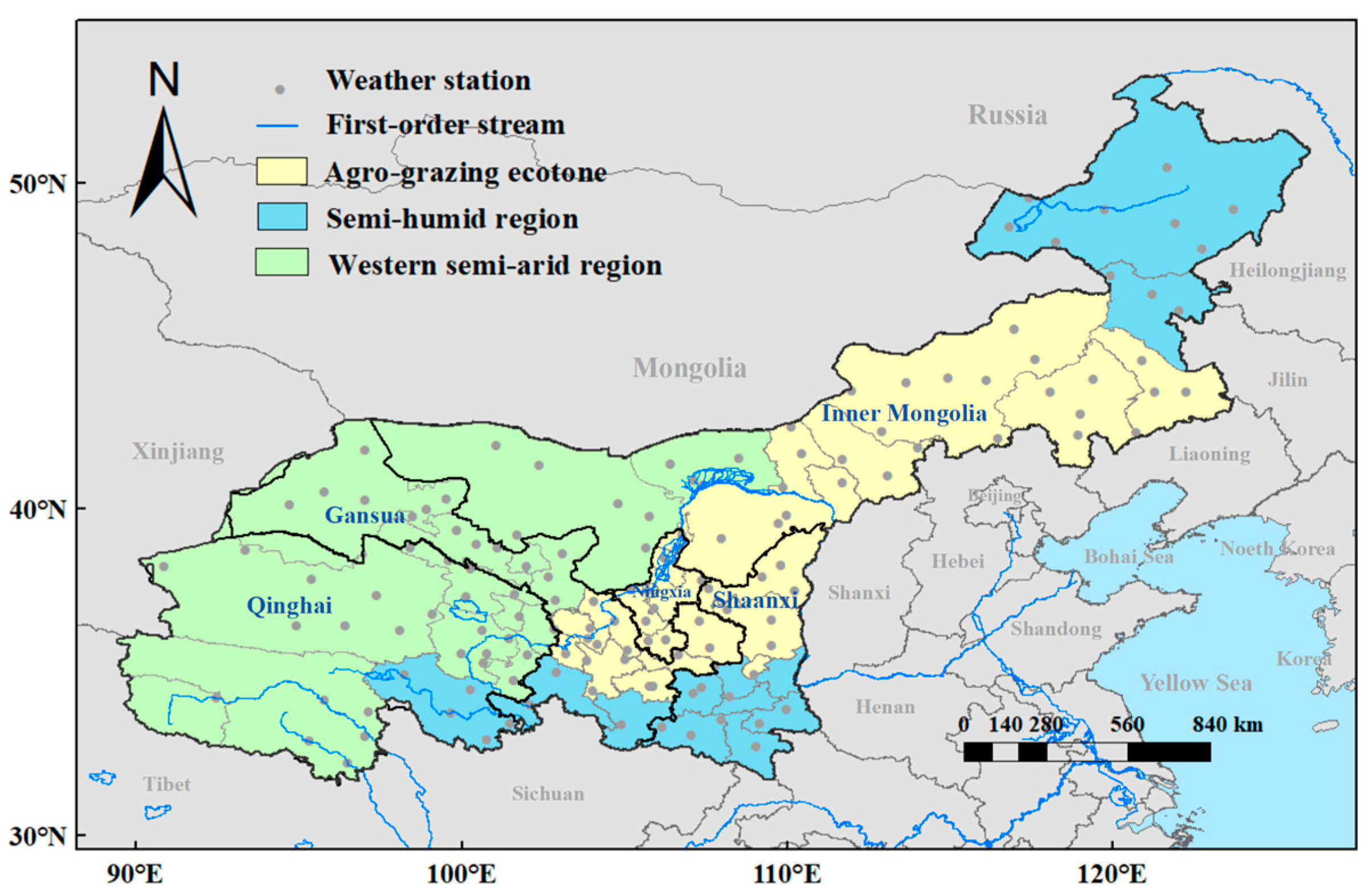
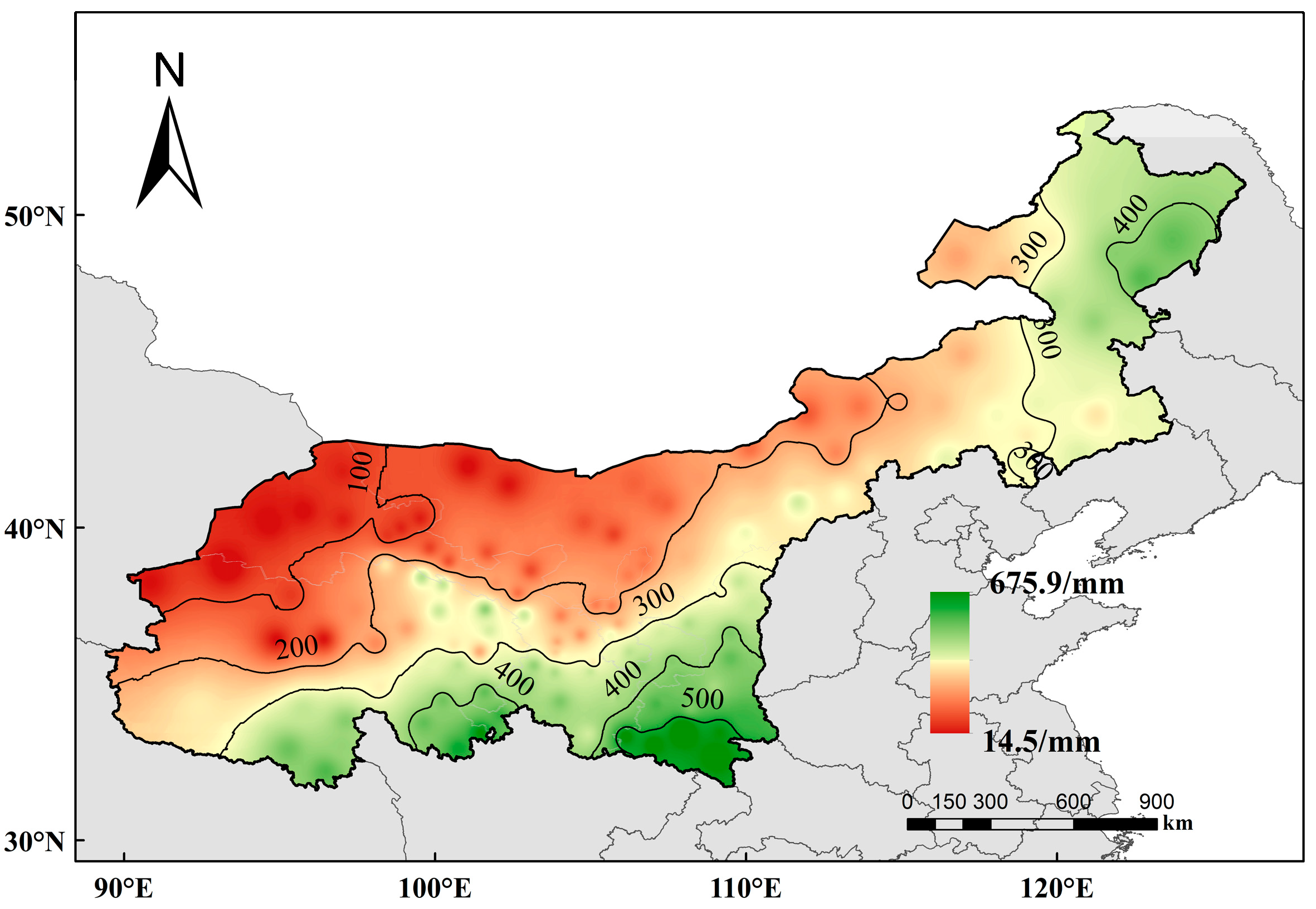
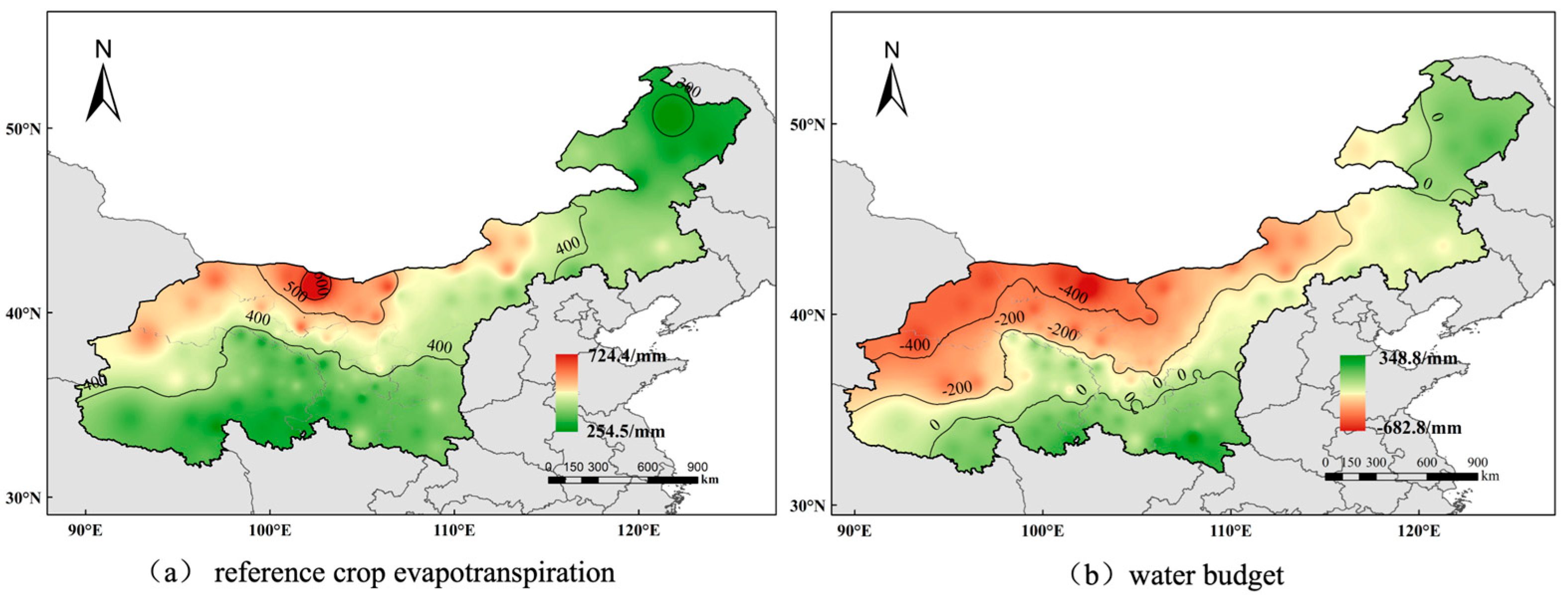
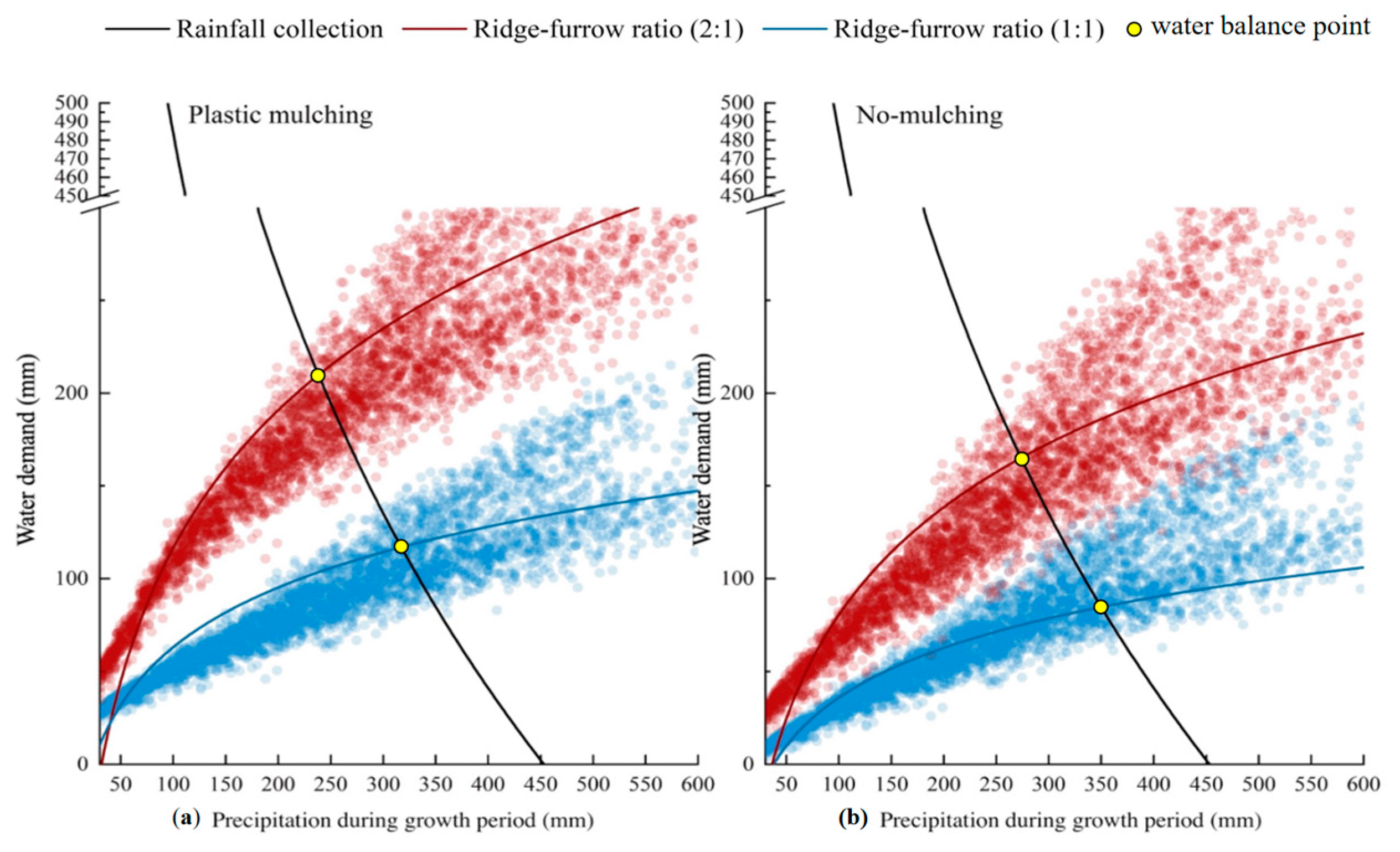
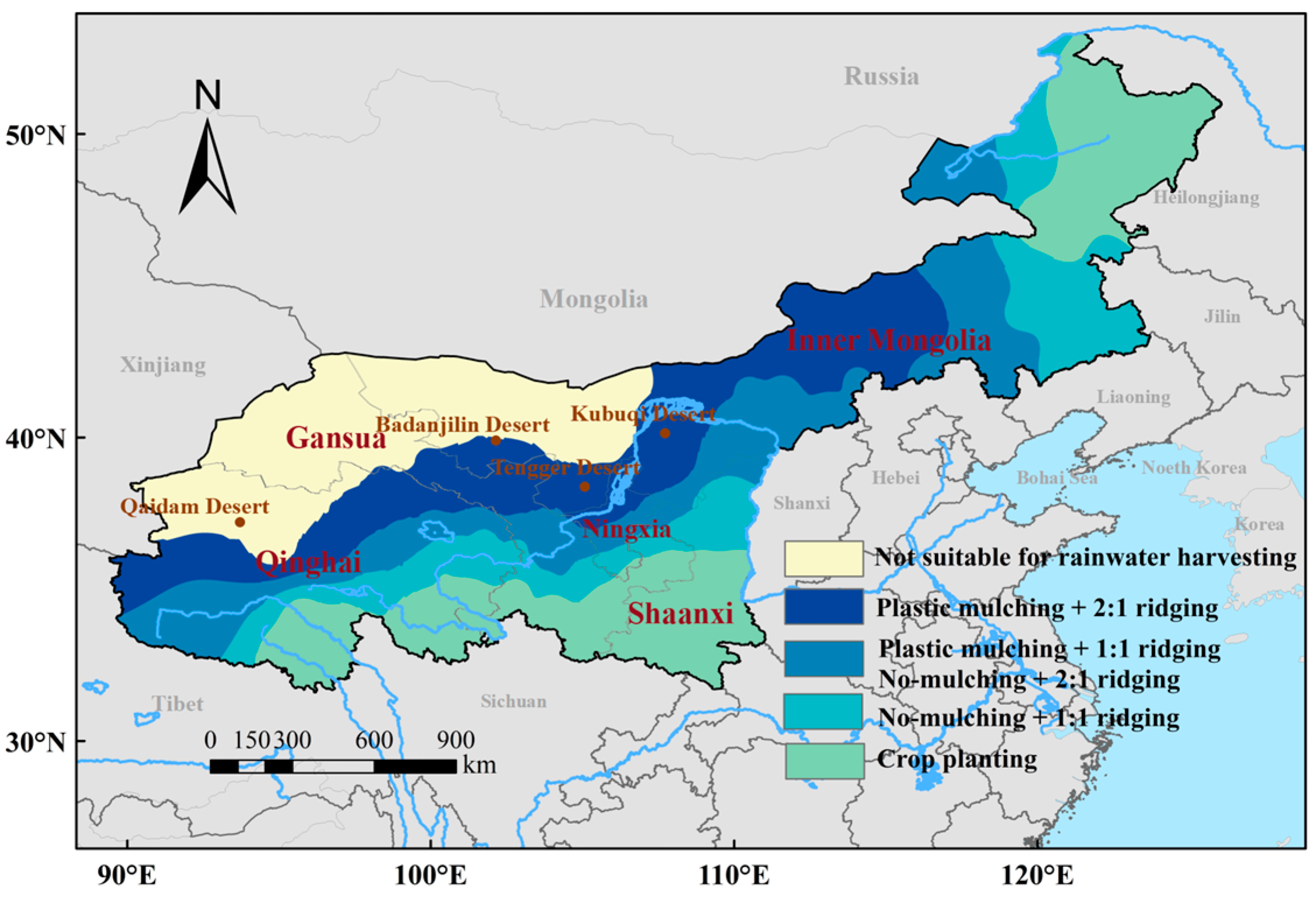
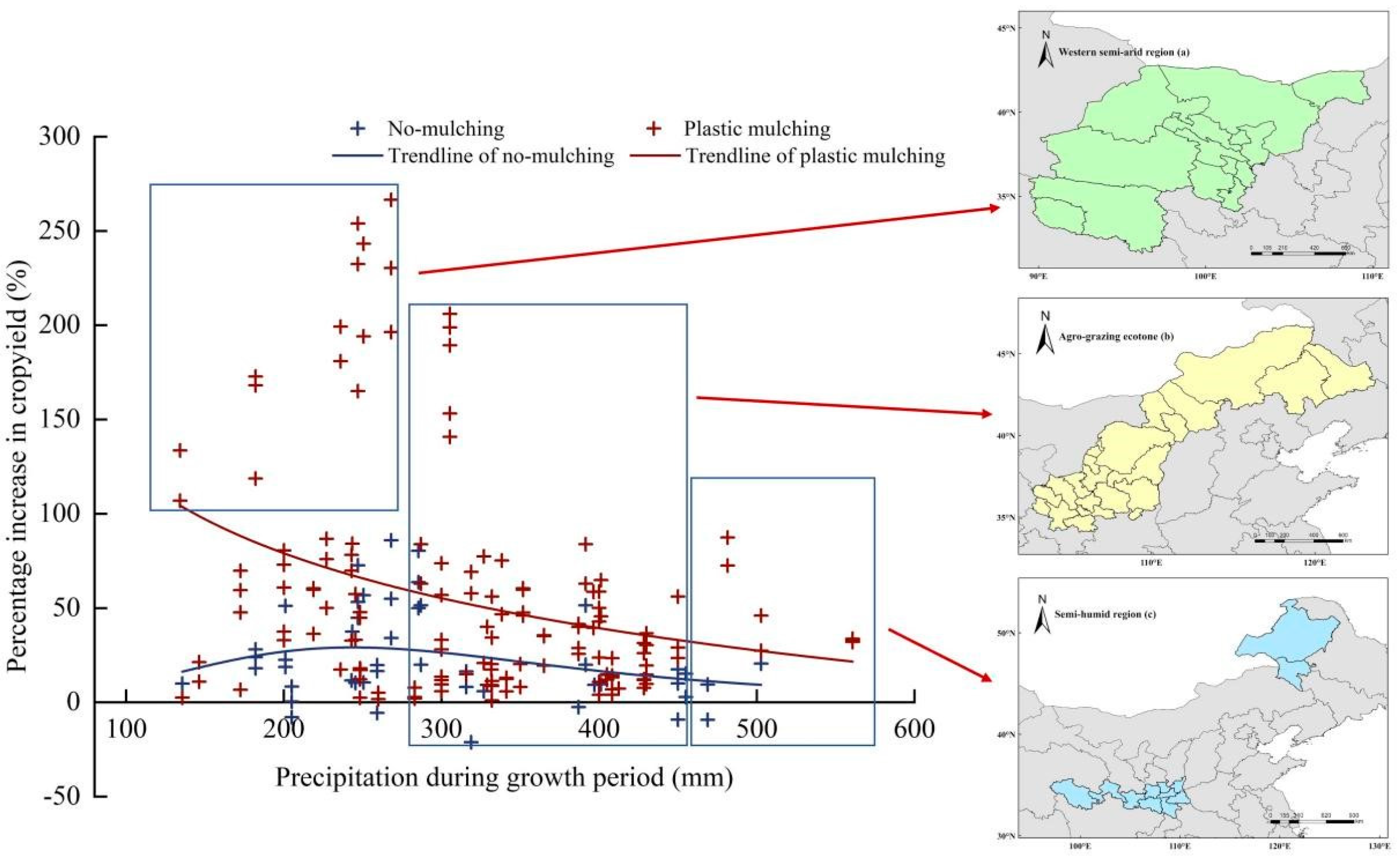
Disclaimer/Publisher’s Note: The statements, opinions and data contained in all publications are solely those of the individual author(s) and contributor(s) and not of MDPI and/or the editor(s). MDPI and/or the editor(s) disclaim responsibility for any injury to people or property resulting from any ideas, methods, instructions or products referred to in the content. |
© 2024 by the authors. Licensee MDPI, Basel, Switzerland. This article is an open access article distributed under the terms and conditions of the Creative Commons Attribution (CC BY) license (https://creativecommons.org/licenses/by/4.0/).
Share and Cite
Zhang, L.; Ren, S.; Pan, F.; Zhou, J.; Jiang, J.; Pan, X.; Wang, J.; Sun, B.; Hu, Q. Optimizing Ridge–Furrow Rainwater-Harvesting Strategies for Potato Cultivation in the Drylands of Northwestern China: A Regional Approach. Agronomy 2024, 14, 1759. https://doi.org/10.3390/agronomy14081759
Zhang L, Ren S, Pan F, Zhou J, Jiang J, Pan X, Wang J, Sun B, Hu Q. Optimizing Ridge–Furrow Rainwater-Harvesting Strategies for Potato Cultivation in the Drylands of Northwestern China: A Regional Approach. Agronomy. 2024; 14(8):1759. https://doi.org/10.3390/agronomy14081759
Chicago/Turabian StyleZhang, Lina, Siqi Ren, Feifei Pan, Jianshuo Zhou, Jingyan Jiang, Xuebiao Pan, Jing Wang, Baoru Sun, and Qi Hu. 2024. "Optimizing Ridge–Furrow Rainwater-Harvesting Strategies for Potato Cultivation in the Drylands of Northwestern China: A Regional Approach" Agronomy 14, no. 8: 1759. https://doi.org/10.3390/agronomy14081759
APA StyleZhang, L., Ren, S., Pan, F., Zhou, J., Jiang, J., Pan, X., Wang, J., Sun, B., & Hu, Q. (2024). Optimizing Ridge–Furrow Rainwater-Harvesting Strategies for Potato Cultivation in the Drylands of Northwestern China: A Regional Approach. Agronomy, 14(8), 1759. https://doi.org/10.3390/agronomy14081759






